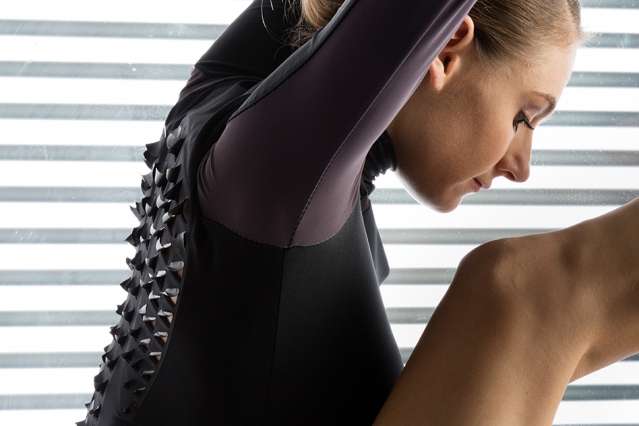A living, breathing textile aims to enhance athletic performance

Textile production has historically been a bellwether for innovations in manufacturing—from technological improvements such as the spinney jenny and the flying shuttle at the dawn of the Industrial Revolution to recent developments in electronic and reactive textiles by designers such as Joanna Berzowska MS '99, who are transforming fabrics into wearable computers. Now, bioLogic, a research team in the Tangible Media Group within the MIT Media Lab, has created a completely new form of performance fabric that combines biomaterials research with textile design. BioLogic is growing living actuators and synthesizing responsive bio-skin in the era where, they declare, "bio is the new interface." They say, "we are imagining a world where actuators and sensors can be grown rather than manufactured, being derived from nature as opposed to engineered in factories."
Under the direction of Professor Hiroshi Ishii, the bioLogic team has unearthed a new behavior of the ancient bacteria Bacillus subtilis natto: the expansion and contraction of the natto cells relative to atmospheric moisture. The team is capitalizing on this natural phenomenon by embedding the bacteria into fabric to ventilate garments. They harvest the animate natto cells in a bio lab and assemble them with a micron-resolution bio-printing system, transforming them into responsive fashion, a "second skin." The synthetic bio-skin reacts to body heat and sweat, causing flaps around heat zones to open, enabling sweat to evaporate and cool down the body through an organic material flux.
Together with New Balance, bioLogic is applying this technology to creating sportswear that regulates athletes' body temperatures, thereby enhancing performance. Lining Yao, who is responsible for concept creation, interaction design, and fabrication for bioLogic, explains, "We are trying to explore how the physical materials and physical environment can be smarter, more adaptive, and become part of us. This garment will understand when you sweat, and it will sense and open up to release your sweat, and close up to keep you warm again. A garment can become an interface that can communicate with your body. The reason we started to explore this bacteria is that we knew that in the natural world there are a lot of smart materials that are naturally responsive. It's very sensitive to even tiny changes in the skin condition, so we thought an on-skin transformable textile would be a really interesting application."
Beyond the industrial collaboration, a grant from the MIT Council for the Arts enabled bioLogic to invite fashion- and product designers from the Royal College of Art, Oksana Anilionyte and Helene Steiner, to bring the project to a new artistic level. Yao explains that bioLogic chose to focus their efforts on the more cutting-edge technological, artistic, or conceptual ideas, and hope some of the pragmatic concerns—like washing and caring for garments made from the "bio-skin"—will be addressed by the wider design community who produce and use the fabric. The project has already piqued the interest of several fashion designers from Central Saint Martins and Parsons, who see a number of potential uses, including creating a garment for Korean women who fish and using this natural nanoactuator to explore other forms of clothing.
While this project appeals to fashion designers and those creating athletic attire, Ishii points out that the Tangible Media Group focuses on diverse actuated materials: "This is one specific instance. We are not really dedicated to fashion design or dance performance wear, but for this project we did specific experiments applying to those areas. We are devoted to the much more fundamental concept of 'radical atoms.' Basically, we are interested in materials that artists and designers would use to express their ideas. For example, a product designer may use metal or glass or plastic. Computer designers may use a pixel in the computer screen, but that's intangible. Physical materials are nice, but frozen; they're dead. So we are interested in making materials that transform dynamically. That's what we call 'radical atoms.'"
Yao says this project aligned perfectly with the group's vision of "human interaction with future dynamic materials." She adds that "the general idea is not only how you can be inspired by nature, but how you can collaborate with nature."
Provided by Massachusetts Institute of Technology
This story is republished courtesy of MIT News (web.mit.edu/newsoffice/), a popular site that covers news about MIT research, innovation and teaching.





















